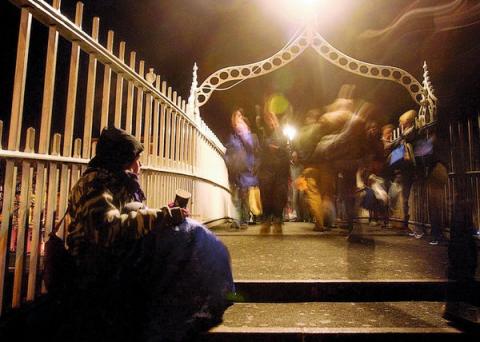Claimed drop in poverty inconsistent with reality, say charities

- CSO figures put 2008 Consistent Poverty rate at 4.2%, down from 5.1% in 2007
- Cut in welfare payments in budget will increase poverty
- St Vincent de Paul spending nearly €1m per week on aid
Despite recent figures released by the Central Statistics Office (CS0) indicating a drop in consistent poverty, Irish charities have reported increased demand for their services in 2008. The CSO’s annual Survey on Income and Living Conditions (SILC) recently reported that the consistent poverty rate had dropped from 5.1% in 2007 to 4.2% in 2008. Consistent poverty is defined as having an income less than 60% of the national median and being without two or more items from a list of eleven ‘deprivation items’ (see panel below), which includes criteria such as the ability to afford two strong pairs of shoes or a warm winter coat.
Speaking to Politico.ie, National Vice-President of The Society of St. Vincent de Paul (SVP) John Monaghan said that SVP had received increased calls for assistance in 2008.
“Calls for the entire country are up around 35%, and the most frequent requests are from families with children and single parent families. The problem we’re facing is that we’re seeing more people coming to us than ever before looking for basic needs like the cost of food or the cost of energy bills. In 2008 we spent over €6.1m on food and €3.8m on energy bills.”
In relation to the reported drop in consistent poverty, Monaghan replied that “given the number of calls we have received and the fact that our expenditure has gone from €46m to over €50m, there is a contradiction (between the experiences of the SVP and the CSO figures) that we can’t square away.”
Fr. Sean Healy, head of Social Justice Ireland, described the consistent poverty scale as “a number that makes no sense in measuring poverty in any meaningful way. That would not be the major number (in the report) as far as we’re concerned”. Fr. Healy was eager to point out that the most important number in the report as far as he was concerned was the percentage of the population at risk of poverty, which also fell from 16.5% to 14.4% in 2008.
“We welcome this drop” Fr Healy told Politico.ie, “but the fall in numbers at risk of poverty is very substantially due to the increases in social welfare. It is quite clear that if there are any cuts in welfare rates in budget 2010 then there will be an increase in poverty. To highlight that point, the CSO study shows that 43% would be at risk of poverty if there was no social welfare payments.”
Fr Healy also pointed to the regional disparity in Irish poverty rates, and stressed that a more nuanced approach from Government is essential to solving this problem.
“In Dublin and on the east coast, the rate is 10%. In the midlands, it is 23% and in the west it is 22%. In the border region it is 16%. There are huge regional disparities that need to be addressed. There should be regional policy focus.”
Peter McVerry of the Fr Peter McVerry trust, which works with homeless young people and those on the margins of society, stressed that the reality of day-to-day life for those he works with has not meaningfully changed despite the recorded decrease in levels of consistent poverty.
“I wouldn’t have noticed any difference in their lifestyle. In budget 2007 social welfare increases exceeded the rise in inflation and that has lifted some people up relative to those in employment, but it hasn’t made any perceptible difference to the young people I work with.”
Fr McVerry added his voice to those calling for the protection of social welfare levels in the upcoming budget.
“With the McCarthy report and the cuts that have already taken place and those that are promised, life is going to become much more difficult. A lot of people are asking for help now that the social welfare Christmas bonus has been abolished. That was a lifeline for people on social welfare, used for buying presents or clothes for themselves. Of all the cuts in social welfare that have taken place I think this is the cruelest of all. It makes Christmas, which is already a pretty miserable time, even more difficult for those in difficulty.”
Fr McVerry also pointed out the dangers to those in work of lowering the minimum wage.
“A measure to lower the minimum wage would be retrograde. It would push working people into consistent poverty. As can be seen from the SILC, it is the children who suffer, as 38 per cent of people in consistent poverty are children”.
What defines poverty? The CSO’s 11 ‘Deprivation Indicators’
• Without heating at some stage in the last year
• Unable to afford a morning, afternoon or evening out in the last fortnight
• Unable to afford two pairs of strong shoes
• Unable to afford a roast once a week
• Unable to afford a meal with meat, chicken or fish every second day
• Unable to afford new (not second-hand) clothes
• Unable to afford a warm waterproof coat
• Unable to afford to keep the home adequetly warm
• Unable to afford to replace any worn out furniture
• Unable to afford to have family or friends for a drink or meal once a month
• Unable to afford to buy presents for family or friends at least once a year
Download the full 2008 Survey on Income and Living Conditions here
